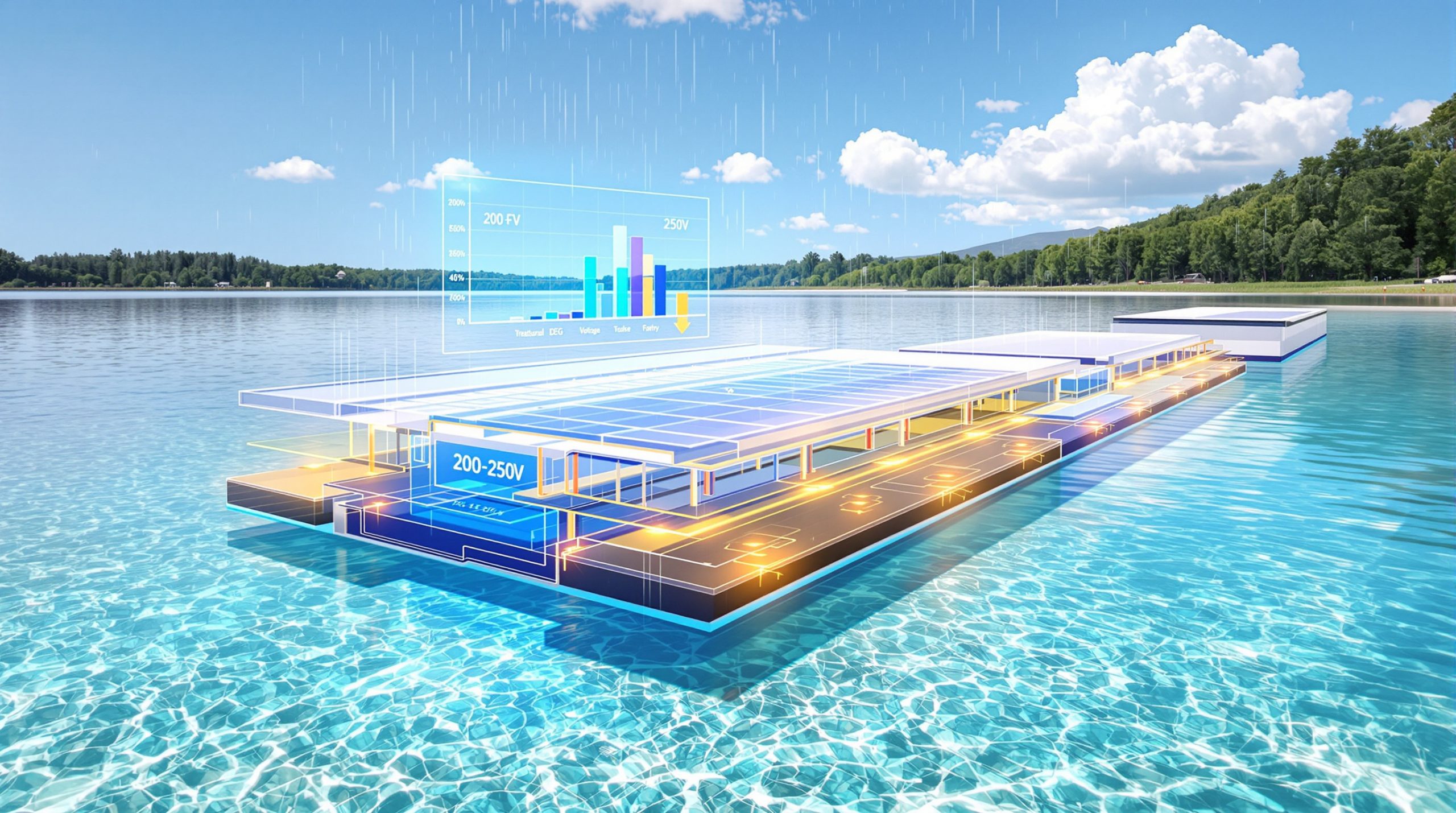The scientific community continues exploring innovative approaches to renewable energy generation, with floating droplet electricity generator technology emerging as a promising solution for harvesting power from aquatic environments. Recent advances in hydrovoltaic energy systems demonstrate remarkable potential for transforming water surfaces into active power generation sites while addressing critical challenges in land use and installation costs. This technological evolution builds upon fundamental principles that have existed in nature for millennia, now harnessed through sophisticated engineering approaches with significant energy transition implications.
Understanding Hydrovoltaic Energy Harvesting Fundamentals
The triboelectric effect serves as the cornerstone of hydrovoltaic energy conversion. When materials with different electron affinities come into contact and separate, electron transfer occurs, creating electrical potential differences. In aqueous environments, this process becomes significantly enhanced through the ionic conductivity of water, which facilitates charge transfer and distribution across the generator surface.
Surface tension dynamics play a crucial role in maintaining consistent electrical contact between raindrops and dielectric materials. Water exhibits a surface tension coefficient of approximately 72.75 mN/m at 20°C, enabling droplets to maintain cohesion during impact while facilitating rapid drainage without waterlogging the generator surface.
What Makes Water-Based Energy Generation Possible?
Charge separation mechanics in floating droplet electricity generator systems operate through instantaneous voltage spikes generated during raindrop impact events. Research demonstrates that triboelectric charge accumulation in water-based systems can reach densities of 10-100 μC/cm², depending on material composition and environmental conditions. Furthermore, the electrochemical potential differences arise from ionic concentration gradients naturally present in water bodies.
Dissolved minerals create electrochemical environments that enhance overall electrical output. This natural enhancement demonstrates how scientists are developing innovative methods to harness renewable energy from previously untapped sources.
Core Components of Floating DEG Systems
Modern floating droplet electricity generator architecture represents a fundamental departure from conventional land-based systems. The integration of buoyant support eliminates the need for heavy structural frameworks while maintaining electrical performance. Chinese researchers at Nanjing University of Aeronautics and Astronautics have demonstrated that strategic material substitution can achieve 87% material weight reduction compared to traditional installations.
Dielectric film layers form the active electrical generation surface in floating systems. These polymer-based materials are positioned within the triboelectric series to optimize electron affinity differences. Film thickness ranges from 100-500 micrometers, carefully calibrated to balance charge generation capacity against cost considerations.
Electrode Configuration and Buoyancy Integration
Electrode configuration in aqueous environments requires specialized design considerations. Conductive pathways must facilitate rapid charge collection from the dielectric surface while preventing charge leakage through the surrounding water medium. Materials selection focuses on corrosion resistance against dissolved salts and biological activity common in natural water bodies.
| System Component | Traditional DEG | Floating DEG | Performance Difference |
|---|---|---|---|
| Material Weight | Baseline | 87% reduction | Significant improvement |
| Manufacturing Cost | Baseline | 50% reduction | Substantial savings |
| Voltage Output Range | 200-250V | 200-250V | Equivalent performance |
| Installation Complexity | High | Low | Simplified deployment |
| Maintenance Access | Difficult | Easy | Enhanced serviceability |
The buoyancy integration principles eliminate traditional foundation requirements through hydrostatic pressure stabilisation. Closed-cell polymeric flotation elements provide upward buoyant force while integrating seamlessly with electrical components. However, buoyancy calculations ensure optimal submergence depth for raindrop capture while maintaining stability under wind stress and wave action.
Engineering Architecture of Floating Power Systems
The architectural philosophy of floating droplet electricity generator systems fundamentally reimagines renewable energy infrastructure. Rather than imposing rigid structures upon terrestrial landscapes, these systems integrate harmoniously with aquatic environments using natural buoyancy principles to support electrical components. Consequently, this approach delivers substantial decarbonisation benefits through reduced material consumption and simplified manufacturing processes.
Weight Reduction Strategies Through Water Integration
Conventional electricity generators require substantial base mass to resist bending moments and maintain structural stability against environmental loads. Floating designs distribute these mechanical stresses across water surfaces, eliminating heavy concrete foundations and steel support frameworks. The 87% weight reduction achieved by floating systems results from substituting expensive structural materials with cost-effective polymeric buoyancy elements.
Water's buoyant support removes traditional foundation engineering requirements and load-bearing structure calculations. The floating system operates as a semi-submerged platform where hydrostatic pressure provides natural stabilising force. This simplification extends to component design, enabling thinner walls, lighter fasteners, and reduced material specifications without compromising structural integrity.
Cost Optimisation Through Material Substitution
The 50% cost reduction demonstrated in floating systems stems from eliminating expensive infrastructure components. Manufacturing costs decline through reduced machine time, simplified tooling requirements, and elimination of site-specific customisation. Furthermore, transportation costs also decrease significantly, as lighter units require smaller vehicles and lower fuel consumption for deployment.
Installation complexity reduction represents another major economic advantage. Land-based systems require site preparation, foundation excavation, and permanent anchoring using specialised heavy equipment. In contrast, floating installations eliminate these requirements, reducing deployment time from weeks to hours through simple mooring operations.
Operational Mechanics and Energy Conversion Process
The energy conversion process in floating systems occurs through rapid charge accumulation cycles triggered by raindrop impacts. When precipitation strikes the dielectric surface, kinetic energy transfer creates instantaneous electrical potential through the triboelectric effect. A typical raindrop with 4-5 mm diameter impacting at terminal velocity carries approximately 0.03-0.05 mJ of kinetic energy.
Raindrop Impact Dynamics and Charge Generation
The contact-separation cycle creates voltage spikes as droplets impact and separate from the generator surface. Multiple raindrops in succession accumulate charge that can be stored in capacitive elements for later use. The floating device developed by Chinese researchers demonstrated the ability to charge capacitors to useful voltages within minutes of operational testing.
Surface tension utilisation enables efficient droplet removal through specially designed drainage systems. The drainage holes allow water movement downward using water's natural surface tension properties, preventing interference with electrical performance. For instance, this design feature maintains consistent operation across varying precipitation intensities and environmental conditions.
Pulse-Based Electricity Production Patterns
Energy generation occurs in discrete pulses corresponding to individual raindrop impacts. The 200-250V output range maintained by floating systems matches conventional installations, demonstrating that aqueous medium conductivity does not degrade charge separation mechanisms. Additionally, electrode configuration optimisation ensures voltage consistency despite the electrically conductive aquatic environment.
The rapid capacitor charging demonstrated in field testing suggests high instantaneous power delivery during precipitation events. Energy flux measurements indicate performance in the milliwatt-to-watt range per raindrop impact, sufficient for practical applications in remote power systems and autonomous electronic devices.
Scalability and Real-World Applications
Field testing on Donghua Lake in Nanjing, China, validated the practical deployment potential of floating technology. The system maintained functionality across variable environmental conditions including natural biofouling, seasonal temperature fluctuations, and varying water chemistry compositions. These developments align with broader sustainability transformation initiatives across multiple industries.
Deployment Scenarios and Environmental Adaptability
Lake and reservoir installations offer optimal conditions for floating generator deployment. These environments provide stable water surfaces with predictable seasonal variations and manageable wave action. The absence of tidal forces simplifies anchoring requirements while maintaining consistent operational depth.
Coastal water deployment presents additional opportunities despite increased environmental challenges. Salt water tolerance testing demonstrated system functionality across varying salinity levels, though long-term material degradation requires ongoing evaluation. Consequently, coastal installations must account for tidal variations and increased wave energy through enhanced anchoring systems.
River system integration possibilities depend on flow rates and seasonal variations. Low-flow periods enable effective operation, while high-flow conditions may require temporary retrieval or specialised anchoring designs. The modular nature of floating systems facilitates rapid deployment and retrieval as river conditions change.
Power Output Capabilities and Electronic Applications
Small electronics powering represents the most immediate application for floating systems. Wireless sensor networks, environmental monitoring equipment, and communication devices can operate autonomously using harvested raindrop energy. The demonstrated capacitor charging timeframes enable practical energy storage for intermittent power demands.
Multi-unit array configurations expand power generation potential through parallel operation of multiple floating generators. Array spacing optimisation prevents interference between units while maximising surface area coverage. However, grid connection possibilities emerge for larger installations, potentially contributing to distributed renewable energy portfolios.
Comparative Analysis: Traditional vs. Floating Systems
The performance equivalence between floating and conventional systems validates the technological feasibility of water-supported designs. Maintaining the same 200-250V output while achieving dramatic reductions in weight and cost represents significant engineering advancement. This progress demonstrates how researchers are making floating generators practical for real-world applications.
Environmental Impact and Land Use Considerations
Land use elimination addresses a critical limitation of conventional renewable energy installations. Floating systems preserve terrestrial ecosystems while generating power from aquatic surfaces that would otherwise remain undeveloped. This approach avoids conflicts with agricultural land use and habitat preservation efforts.
The carbon footprint of floating systems compares favourably with conventional renewables due to reduced material requirements and simplified manufacturing processes. The 50% cost reduction correlates with proportional decreases in energy consumption during production phases.
Installation and Maintenance Advantages
Maintenance accessibility represents a significant operational advantage for floating systems. Units can be retrieved for service using simple winching operations, whereas land-based installations require on-site technical work or removal by heavy equipment. This accessibility reduces long-term operational costs and enables more frequent preventive maintenance.
Deployment flexibility allows seasonal repositioning based on optimal precipitation patterns or water level variations. Systems can be relocated to maximise energy generation or removed during adverse weather conditions, enhancing equipment longevity and performance consistency.
Technical Challenges and Engineering Solutions
Despite demonstrated advantages, floating systems face several technical challenges requiring ongoing engineering development. Long-term durability in aquatic conditions presents the primary concern, particularly regarding material degradation from UV exposure, biological colonisation, and chemical interaction with dissolved substances.
Biofouling Prevention and Material Durability
Natural water environments contain microorganisms and larger biological entities that can colonise generator surfaces. Biofouling prevention strategies must balance effective anti-microbial properties with environmental compatibility and electrical performance maintenance. Testing in natural lake water demonstrated system tolerance for biological activity, though long-term studies remain necessary.
UV radiation exposure represents another durability concern for floating systems. Polymer dielectric materials require photostabilisation to maintain electrical properties over multi-year operational periods. Research into UV-resistant formulations continues to address this challenge while preserving cost advantages.
Electrical Isolation and Safety Considerations
Electrical isolation in aquatic environments requires careful design attention to prevent shock hazards and system failures. Insulation systems must prevent current leakage through surrounding water while maintaining operational accessibility for maintenance activities. Furthermore, safety protocols for deployment and service operations require development as the technology advances toward commercial implementation.
Grid integration capabilities for larger installations necessitate specialised inverter systems adapted for variable pulse-based energy generation. Power conditioning equipment must accommodate the unique output characteristics of raindrop-driven generators while meeting utility interconnection standards.
Future Development Pathways
Commercial scalability of floating technology depends on continued material science advances and manufacturing cost optimisation. Research directions focus on enhanced efficiency through improved material pairings and optimised surface textures for maximum triboelectric effect generation. These developments complement emerging innovation trends in mining and other resource sectors.
Manufacturing Scale-Up and Cost Reduction
Large-scale manufacturing implementation could further reduce the demonstrated 50% cost savings through economies of scale and automated production techniques. Standardised module designs enable mass production while maintaining quality consistency across installations.
Supply chain development for specialised materials and components requires coordination with polymer manufacturers and electronics suppliers. Integration with existing renewable energy supply chains could accelerate commercial adoption and reduce distribution costs.
Hybrid System Integration
Combination with solar and wind renewable technologies offers synergistic benefits through complementary generation patterns. Floating platforms could integrate photovoltaic panels for additional energy collection during non-precipitation periods, maximising aquatic surface utilisation.
Smart grid integration capabilities enable dynamic load balancing and energy storage optimisation across multiple generation sources. Advanced control systems could coordinate floating generator arrays with conventional renewable installations for enhanced grid stability.
Economic and Environmental Impact Assessment
The broader implications of hydrovoltaic systems extend beyond immediate energy generation to encompass land use preservation, ecosystem protection, and distributed energy network development. Economic viability in different geographic regions depends on precipitation patterns, water body availability, and local energy costs. Additionally, these systems offer potential for sustainable battery recycling integration in comprehensive renewable energy solutions.
Market Positioning Within Renewable Energy Landscape
Floating systems occupy a complementary niche alongside established solar and wind technologies. Rather than competing directly with large-scale installations, these systems excel in specialised applications requiring distributed generation and minimal environmental impact.
Remote area applications represent the most promising initial market segment. Locations lacking electrical grid access but featuring abundant water bodies and precipitation could benefit significantly from autonomous floating generator installations. The technology transfer potential to developing regions offers additional market opportunities.
Long-Term Sustainability Considerations
Environmental compatibility requires ongoing assessment of ecosystem impacts from floating installations. Initial studies suggest minimal disruption to aquatic environments, though comprehensive ecological evaluations across diverse water body types remain necessary.
Replacement cycle projections based on material degradation rates indicate operational lifespans comparable to conventional renewable installations. Performance degradation patterns follow predictable curves, enabling planned replacement schedules and lifecycle cost optimisation.
The integration of floating technology into existing renewable energy portfolios represents a significant step toward comprehensive clean energy solutions. As material science continues advancing and manufacturing scales increase, these innovative systems may contribute substantially to distributed power generation networks while preserving valuable terrestrial resources for other critical applications.
Disclaimer: This analysis is based on current research findings and technological demonstrations. Commercial viability and long-term performance projections involve inherent uncertainties that may affect actual results. Readers should consult current scientific literature and conduct independent assessments before making investment or deployment decisions.
Looking to Invest in the Next Energy Revolution?
Discovery Alert's proprietary Discovery IQ model delivers real-time alerts on significant ASX mineral discoveries, including critical minerals essential for renewable energy infrastructure like floating droplet electricity generators. Explore how major discoveries can generate substantial returns by visiting Discovery Alert's dedicated discoveries page and begin your 30-day free trial today to position yourself ahead of the market.




